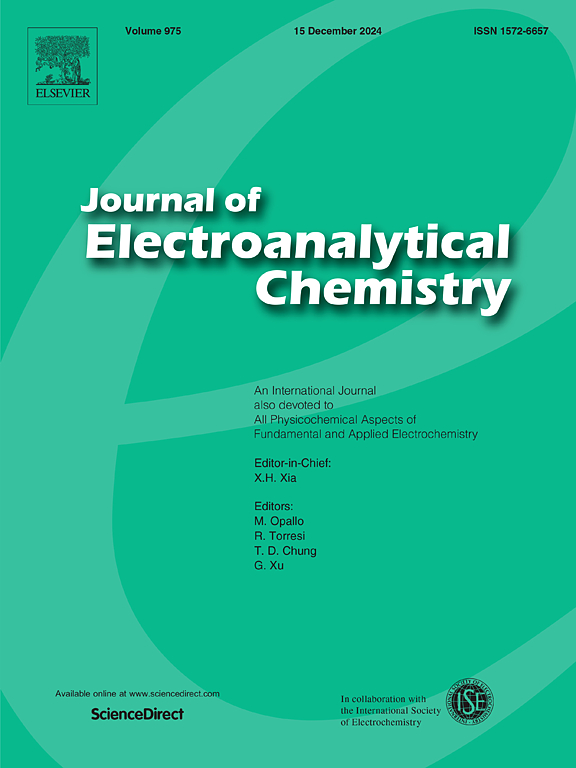用于储能应用的硫化铅-氧化石墨烯混合纳米结构的物理化学和电化学研究
IF 4.1
3区 化学
Q1 CHEMISTRY, ANALYTICAL
引用次数: 0
摘要
具有更高比电容(Cs)和更长循环寿命的先进电极正成为储能设备中过渡金属硫化物复合材料的重要趋势。因此,本研究采用简单的水热法有效地制备了硫化铅-氧化石墨烯(PbS/GO)纳米杂化物,从而限制了团聚并提高了所开发电极的电化学性能。扫描电子显微镜(SEM)检查验证了 PbS 片在 GO 片上的分布,从而提高了性能。在超级电容器中用作电极的纳米杂化物在三电极设置的 2.0 M KOH 中,电流密度 (j) 为 1 A/g 时的 Cs 值为 1371.57 F/g。值得注意的是,它在 4,000 次循环中保持了 94.12 % 的优异比电容。此外,不对称配置(PbS/GO//AC)在 1 A/g 时的 Cs 值达到了 251 F/g,在 252 W/kg 的功率密度下工作时,能量密度达到了 17 Wh/kg,表现更为出色。出色的电化学性能源于混合电极的大表面积(121.61 m2/g)和介孔性质,这为氧化还原过程中电解质的相互作用提供了额外的通道和电活性位点。此外,PbS 纳米片在导电 GO 纳米片上的均匀装饰减少了团聚,有助于伪电容行为。因此,PbS/GO 混合电极的优异性能为便携式和可穿戴电子设备中使用的先进超级电容器带来了巨大前景。本文章由计算机程序翻译,如有差异,请以英文原文为准。
Physicochemical and electrochemical investigation of lead sulphide-graphene oxide hybrid nanostructure for energy storage applications
The emerging trend of advanced electrodes with greater specific capacitance (Cs) and favourable cycle life is acquiring significant attention of transition metal sulphide composites for energy storage devices. Therefore, this study demonstrates the effective creation of lead sulphide-graphene oxide (PbS/GO) nanohybrid using a simple hydrothermal method, which restricts agglomeration and enhances the electrochemical properties of the developed electrodes. The scanning electron microscopy (SEM) examination verified the distribution of PbS flakes on GO sheets, improving the performance. The nanohybrid employed as an electrode in supercapacitors demonstrated a Cs of 1371.57 F/g at a current density (j) of 1 A/g in a 2.0 M KOH using a three-electrode setup. Remarkably, it retained an exceptional specific capacitance of 94.12 % over 4,000 cycles. Furthermore, the asymmetric configuration (PbS/GO//AC) achieves a more excellent Cs of 251 F/g at 1 A/g and an impressive energy density of 17 Wh/kg when operated at a power density of 252 W/kg. The outstanding electrochemical performance results from the extensive surface area (121.61 m2/g) and mesoporous nature of the hybrid electrode, which provides additional passages and electroactive sites for electrolyte interaction during the oxidation–reduction phenomenon. Additionally, the uniform decoration of PbS nanoflakes on conductive GO nanosheets decreases the agglomeration and contributes to the pseudocapacitive behaviour. Therefore, the exceptional performance of the PbS/GO hybrid electrode holds considerable promise for the advanced supercapacitors used in portable and wearable electronics.
求助全文
通过发布文献求助,成功后即可免费获取论文全文。
去求助
来源期刊
CiteScore
7.80
自引率
6.70%
发文量
912
审稿时长
2.4 months
期刊介绍:
The Journal of Electroanalytical Chemistry is the foremost international journal devoted to the interdisciplinary subject of electrochemistry in all its aspects, theoretical as well as applied.
Electrochemistry is a wide ranging area that is in a state of continuous evolution. Rather than compiling a long list of topics covered by the Journal, the editors would like to draw particular attention to the key issues of novelty, topicality and quality. Papers should present new and interesting electrochemical science in a way that is accessible to the reader. The presentation and discussion should be at a level that is consistent with the international status of the Journal. Reports describing the application of well-established techniques to problems that are essentially technical will not be accepted. Similarly, papers that report observations but fail to provide adequate interpretation will be rejected by the Editors. Papers dealing with technical electrochemistry should be submitted to other specialist journals unless the authors can show that their work provides substantially new insights into electrochemical processes.

 求助内容:
求助内容: 应助结果提醒方式:
应助结果提醒方式:


